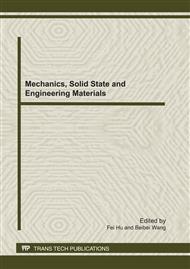[1]
G. Fanchini, V. Gupta, A.B. Mann, M. Chhowalla: In situ monitoring of structural changes in boron carbide under electric fields. J. Am. Ceram. Soc., 91, 8 (2008), pp.2666-2669.
DOI: 10.1111/j.1551-2916.2008.02488.x
Google Scholar
[2]
S. Hayun, D. Rittel, N. Frage, M.P. Dariel: Static and dynamic mechanical properties of infiltrated B4C-Si composites. Mater. Sci. Eng. A 487, 1-2 (2008), pp.405-409.
DOI: 10.1016/j.msea.2007.11.062
Google Scholar
[3]
T.K. Roy, C. Subramanian, A.K. Suri: Pressureless sintering of boron carbide. Ceram. Int. 32, 3 (2006), pp.227-233.
DOI: 10.1016/j.ceramint.2005.02.008
Google Scholar
[4]
H. Lee, R.F. Speyer, W.S. Hackenberger: Sintering of boron carbide heat-treated with hydrogen. J. Am. Ceram. Soc. 85, 8 (2002), pp.2131-2133.
DOI: 10.1111/j.1151-2916.2002.tb00420.x
Google Scholar
[5]
M.W. Chen, J.W. McCauley, J.C. LaSalvia, K.J. Hemker: Microstructural characterization of commercial hot-pressed boron carbide ceramics. J. Am. Ceram. Soc. 88, 7 (2005), pp.1935-1942.
DOI: 10.1111/j.1551-2916.2005.00346.x
Google Scholar
[6]
E.M. Heian, S.K. Khalsa, J.W. Lee, Z.A. Munir: Synthesis of dense, high-defect-concentration B4C through mechanical activation and field-assisted combustion. J. Am. Ceram. Soc. 87, 5 (2004), pp.779-783.
DOI: 10.1111/j.1551-2916.2004.00779.x
Google Scholar
[7]
L.S. Sigl, H.J. Kleebe: Microcracking in B4C-TiB2 composites. J. Am. Ceram. Soc., 78, 9 (1995), pp.2374-2380.
DOI: 10.1111/j.1151-2916.1995.tb08671.x
Google Scholar
[8]
J. Jung, S. Kang: Advances in manufacturing boron carbide-aluminum composites. J. Am. Ceram. Soc. 87, 1 (2004), pp.47-54.
Google Scholar
[9]
T.S. Srivatsan, G. Guruprasad, D. Black, R. Radhakrishnan, T.S. Sudarshan: Influence of TiB2 content on microstructure and hardness of TiB2-B4C composite. Powder Technol. 159, 3 (2005), pp.161-167.
DOI: 10.1016/j.powtec.2005.08.003
Google Scholar
[10]
M.F. Ashby, F.J. Blunt, M. Bannister: Flow characteristics of highly constrained metal wires. Acta Metall., 37, 7(1989), pp.1847-1857.
DOI: 10.1016/0001-6160(89)90069-2
Google Scholar
[11]
J.F. Bartolome, M. Diaz, J.S. Moya: Influence of the metal particle size on the crack growth resistance in mullite-molybdenum composites. J. Am. Ceram. Soc. 85, 11 (2002), pp.2778-2784.
DOI: 10.1111/j.1151-2916.2002.tb00528.x
Google Scholar
[12]
S.I. Cha, S.H. Hon, G.H. Ha, B.K. Kim: Mechanical properties of WC-10Co cemented carbides sintered from nanocrystalline spray conversion processed powders. Int. J. Refract. Met. Hard Mater. 19, 4-6 (2001), pp.397-403.
DOI: 10.1016/s0263-4368(01)00057-9
Google Scholar
[13]
S. Dubey, T.S. Srivatsan, W.O. Soboyejo: Fatigue crack propagation and fracture characteristics of in-situ titanium-matrix composites. Int. J. Fatigue, 22, 2 (2000), pp.161-174.
DOI: 10.1016/s0142-1123(99)00114-0
Google Scholar
[14]
J.A. Yeomans: Ductile particle ceramic matrix composites—Scientific curiosities or engineering materials. J. Eur. Ceram. Soc. 28, 7 (2008), pp.1543-1550.
DOI: 10.1016/j.jeurceramsoc.2007.12.009
Google Scholar
[15]
P. Van Houtte, L. Delannay, S.E. Schoenfeld: The work of crack formation as measure of toughness of hard metals. Int. J. Plasticity Vol. 7(1983), pp.107-110.
Google Scholar
[16]
R. Liu, H. Ru, Y. Zhao, D. Tang: In situ synthesis of B4C ceramics toughened by ZrB2 particles. Chin. J. Mater. Res. 20, 6(2006), pp.611-616.
Google Scholar


